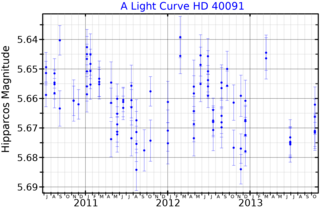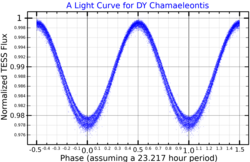
NO Apodis is a solitary, red hued variable star located in the southern circumpolar constellation Apus. It has an average apparent magnitude of 5.86, allowing it to be faintly seen with the naked eye. The object is relatively far at a distance of 790 light years but is drifting closer with a heliocentric radial velocity −18.3 km/s.

HD 24479, also designated as HR 1204, is a solitary, bluish-white hued star located in the northern circumpolar constellation Camelopardalis. The star is visible to the naked eye with an apparent visual magnitude of 5.04. Based on Gaia DR3 parallax measurements, it is located 385 light years from the Sun. However, it is receding with a somewhat constrained heliocentric radial velocity of 4.6 km/s. At its current distance, HD 24479's brightness is diminished by 0.29 magnitudes due to interstellar dust.
HD 126209, also known as HR 5389, is a solitary, orange hued star located in the southern circumpolar constellation Apus. It has an apparent magnitude of 6.06, making it faintly visible to the naked eye under ideal conditions. Based on parallax measurements from the Gaia spacecraft, the object is estimated to be 560 light years distant. It appears to be approaching the Solar System with a fairly constrained heliocentric radial velocity of −8.1 km/s. De Mederios et al. (2014) found the radial velocity to be variable, making it a probable spectroscopic binary. Eggen (1993) lists it as a member of the old disk population.
HD 121439, also known as HR 5240, is a solitary, bluish-white hued star located in the southern circumpolar constellation Apus. It has an apparent magnitude of 6.08, allowing it to be faintly visible to the naked eye. The object is located relatively far at a distance of 774 light years based on Gaia DR3 parallax measurements but is receding with a fairly constrained radial velocity of 4 km/s. At its current distance, HD 121439's brightness is diminished by 0.57 magnitudes due to interstellar dust.

HD 154972, also known as HR 6373 or rarely 56 G. Apodis, is a solitary, bluish-white-hued star located in the southern circumpolar constellation Apus. It has an apparent magnitude of 6.23, placing it near the limit for naked eye visibility. Gaia DR3 parallax measurements place the object 336 light years away, and it is currently drifting closer with a heliocentric radial velocity of −3.1 km/s. At its current distance, HD 154972's brightness is diminished by 0.23 magnitudes due to extinction from interstellar dust. It has an absolute magnitude of +1.11.

HD 57197, also known as M Puppis or HR 2789, is a suspected astrometric binary located in the southern constellation Puppis, the poop deck. It has an apparent magnitude of 5.84, making it faintly visible to the naked eye under ideal conditions. Based on parallax measurements from the Gaia satellite, the system is estimated to be 629 light years away from the Solar System. The value is poorly constrained, but it appears to be receding with a heliocentric radial velocity of 13 km/s. At its current distance, HD 57197's brightness is diminished by 0.3 magnitudes due to interstellar dust. It has an absolute magnitude of -0.43.
1 Trianguli, also known as HD 10407, is a star located in the northern constellation Triangulum. It has an apparent magnitude of 7.52, making it readily visible in binoculars but not to the naked eye. Gaia DR3 parallax measurements imply a distance of 723 light years and it is currently receding with a heliocentric radial velocity of 7 km/s. At its current distance 1 Trianguli's brightness is diminished by a quarter of a magnitudes due to interstellar dust and it has an absolute magnitude of +0.78. Even though it has a Flamsteed designation, 1 Trianguli is one of the 220 Flamsteed stars that are not in the Yale Bright Star Catalogue.
HD 194612 is a solitary orange hued star located in the southern circumpolar constellation Octans. It has an apparent magnitude of 5.9, making it visible to the naked eye under ideal conditions. Parallax measurements place it at a distance of 760 light years and it has a low heliocentric radial velocity of 0.3 km/s.

WZ Columbae, also known as HD 38170, is a solitary, bluish-white hued star located in the southern constellation Columba, the dove. It has an apparent magnitude of 5.28, allowing it to be faintly visible to the naked eye. Based on parallax measurements from the Gaia spacecraft, the object is about 365 light years distant. It appears to be receding from the Solar System, having a heliocentric radial velocity of 36.3 km/s.
HD 222060, also known as HR 8957, is a solitary, orange hued star located in the southern circumpolar constellation Octans. It has an apparent magnitude of 5.98, allowing it to be faintly visible to the naked eye. Based on parallax measurements from GAIA, the object is estimated to be 536 light years distant. It appears to be slowly receding from the Solar System, having a heliocentric radial velocity of 2.3 km/s.

CW Octantis, also known as HD 148542, is a solitary, white hued variable star located in the southern circumpolar constellation Octans. It has an apparent magnitude of 6.03, allowing it to be faintly visible to the naked eye. Parallax measurements from Gaia DR3 place the object at a distance of 629 light years. It appears to be receding from the Solar System with a heliocentric radial velocity of 7.1 km/s.

HD 98617, also known HR 4385, is a double star located in the southern circumpolar constellation Chamaeleon. The system has a combined apparent magnitude of 6.35, placing it near the limit for naked eye. The system is located relatively close at a distance of 206 light years but is approaching the Solar System with a fairly constrained radial velocity of −4 km/s. At its current distance, HD 98617 brightness is diminished by 0.29 magnitudes due to interstellar dust.
HD 218108, also known as HR 8786, is a solitary, white hued star located in the southern circumpolar constellation Octans. It has an apparent magnitude of 6.11, making it faintly visible to the naked eye under ideal conditions. Based on parallax measurements from Gaia DR3, the object is estimated to be 247 light years away. It appears to be approaching the Solar System with a fairly constrained radial velocity of −7 km/s. Paunzen et al. (2001) lists it as a λ Boötis star with a weak magnesium line.

HD 40091, also known as HR 2082, is a solitary star located in the southern constellation Columba, the dove. It has an apparent magnitude of 5.54, making it faintly visible to the naked eye under ideal conditions. Based on parallax measurements from the Gaia spacecraft, the object is estimated to be 501 light years distant. However, it is rapidly receding with a high heliocentric radial velocity of 114 km/s.

23 Leonis Minoris is a solitary, bluish-white hued star located in the northern constellation Leo Minor. It is positioned 7° south and 11" west from β Leonis Minoris. It is rarely called 7 H. Leonis Minoris, which is its Hevelius designation.
HD 191220, also known as HR 7698, is a solitary white hued star located in the southern circumpolar constellation Octans. It has an apparent magnitude of 6.14, placing it near the limit for naked eye visibility. The object is located relatively close at a distance of 245 light years based on Gaia DR3 parallax measurements but is slowly receding with a heliocentric radial velocity of 0.1 km/s. At its current distance, HD 191220's brightness is diminished by 0.22 magnitudes due to interstellar dust.

PW Telescopii, also known as HD 183806 or simply PW Tel, is a solitary variable star located in the southern constellation Telescopium. It has an average apparent magnitude of 5.58, making it faintly visible to the naked eye. Based on parallax measurements from the Gaia satellite, the star is estimated to be 395 light years distant. It appears to be approaching the Solar System with a heliocentric radial velocity of −10 km/s. The value is somewhat constrained, having an uncertainty of 26%. At its current distance, PW Tel's brightness is diminished by 0.05 magnitudes due to interstellar dust.

HD 31134, also designated as HR 1561, is a solitary star located in the northern circumpolar constellation Camelopardalis, the giraffe. It is faintly visible to the naked eye as a white-hued star with an apparent magnitude of 5.74. Gaia DR3 parallax measurements place it 473 light years away. It appears to be approaching the Solar System with a heliocentric radial velocity of −15.1 km/s. At its current distance, HD 31134's brightness is diminished by 0.35 magnitudes due to interstellar dust. It has an absolute magnitude of +0.19.

HD 101917, also designated as HR 4509, or rarely 34 G. Chamaeleontis, is a solitary star located in the southern circumpolar constellation Chamaeleon. It has an apparent magnitude of 6.38, placing it near the limit for naked eye visibility. The object is located relatively close at a distance of 185 light years based on Gaia DR3 parallax measurements but is receding with a heliocentric radial velocity of 33 km/s. At its current distance, HD 101917's brightness is diminished by 0.28 magnitudes due to interstellar dust. It has an absolute magnitude of +2.69.

HD 177406, also known as HR 7223 or rarely 47 G. Telescopii, is a solitary star located in the southern constellation Telescopium. It is faintly visible to the naked eye as a white-hued point of light with an apparent magnitude of 5.95. Gaia DR3 parallax measurements imply a distance of 369 light years and it is currently approaching the Solar System with a heliocentric radial velocity of −6.2 km/s. At its current distance, HD 177406's brightness is diminished by 0.23 magnitudes due to interstellar dust and it has an absolute magnitude of +0.60.










